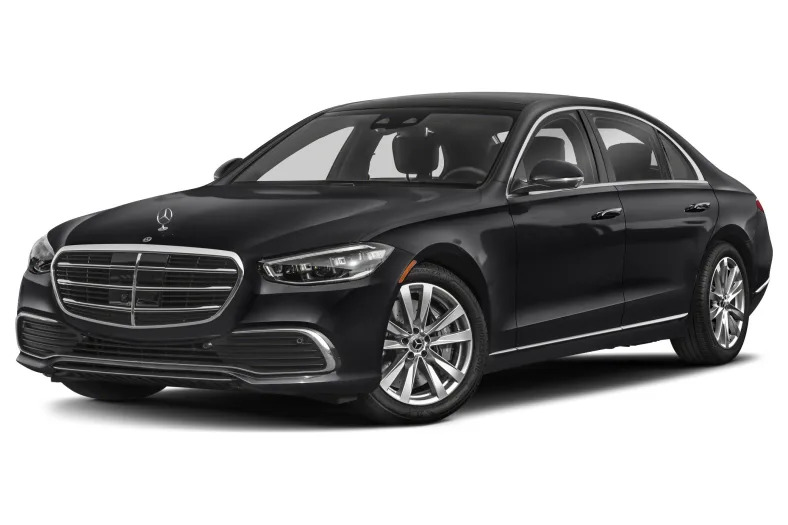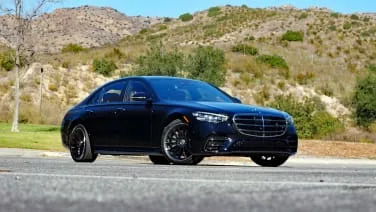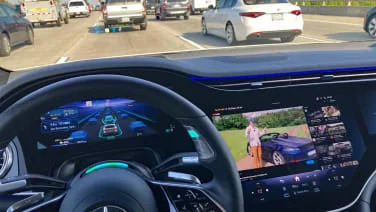2024 Mercedes-Benz S-Class
There is no purely electric version of the Mercedes-Benz S-Class. If you want something like that, you’ll need to go with the Mercedes-Benz EQS Sedan. The “something like that” is the important bit there, because the EQS is awfully different than the S-Class. Just look at it, for one. Its design encompasses a wildly different body style that includes a vast hatchbacked trunk and a back seat that, while similar in terms of legroom, has less headroom and fewer available functional opulences. The EQS is more like an electric cross between an S-Class and a CLS. As much as I like the EQS, I’d rather have this S-Class. Just look at it, for one. Thankfully, if you’re thinking the same thing, there is still an electrified S-Class: this S580e. It’s a plug-in hybrid, and a damn good one, too. Not only is it arguably more appealing than an EQS, it’s also the S-Class I’d get. Hands down, no question. Here are 15 thoughts about why that is. 1. The electric range is huge The EPA says the S580e can travel 46 miles on a single charge, but after every full charge, the car was showing 60 miles. That’s immense for a plug-in hybrid, and even 46 is well above average. Other PHEVs are usually in the 30s. This means you’ll be able to drive around on electricity alone a lot longer, and possibly not have to charge every night. I certainly didn’t. It’s also good because if, like me, you accelerate on the more rapid side, your predicted range is going to drop faster than your actual miles driven. Once that e-range is depleted, things get turned over to a 3.0-liter turbocharged mild-hybrid inline-six, which still gets a bump from the plug-in hybrid’s electric motor. It’s a double hybrid, which sounds unique … and complicated! Then again, this is an S-Class, so par for the course. After recharging three times in a week and going on two longer drives that eliminated the e-range, I averaged 66.3 mpg in about 300 miles of driving. Had I stuck to around-town driving, as is typical, the car would’ve kept on showing 999.99 mpg in the meter. Yay plug-in hybrids. 2. Not so sure about the DC fast-charging option This S580e had the $500 DC fast-charging option. The only other PHEV I’m aware of that has this is the Mitsubishi Outlander. Honestly, I’m not sure why you’d need it. The point of a PHEV is that you don’t need to worry about public charging. And given the prices they charge, you’re not really saving money. I suppose there could be some scenario, possibly while traveling … but I can’t think of it. It's quite hard to take an action shot while driving, so here is basically the same car in Germany 3. Acceleration depends on a lot of factors Per usual, there are different drive modes, but in the S580e’s case, they include powertrain sources as well as chassis factors. This isn’t literally what …
Full Review
There is no purely electric version of the Mercedes-Benz S-Class. If you want something like that, you’ll need to go with the Mercedes-Benz EQS Sedan. The “something like that” is the important bit there, because the EQS is awfully different than the S-Class. Just look at it, for one. Its design encompasses a wildly different body style that includes a vast hatchbacked trunk and a back seat that, while similar in terms of legroom, has less headroom and fewer available functional opulences. The EQS is more like an electric cross between an S-Class and a CLS. As much as I like the EQS, I’d rather have this S-Class. Just look at it, for one. Thankfully, if you’re thinking the same thing, there is still an electrified S-Class: this S580e. It’s a plug-in hybrid, and a damn good one, too. Not only is it arguably more appealing than an EQS, it’s also the S-Class I’d get. Hands down, no question. Here are 15 thoughts about why that is. 1. The electric range is huge The EPA says the S580e can travel 46 miles on a single charge, but after every full charge, the car was showing 60 miles. That’s immense for a plug-in hybrid, and even 46 is well above average. Other PHEVs are usually in the 30s. This means you’ll be able to drive around on electricity alone a lot longer, and possibly not have to charge every night. I certainly didn’t. It’s also good because if, like me, you accelerate on the more rapid side, your predicted range is going to drop faster than your actual miles driven. Once that e-range is depleted, things get turned over to a 3.0-liter turbocharged mild-hybrid inline-six, which still gets a bump from the plug-in hybrid’s electric motor. It’s a double hybrid, which sounds unique … and complicated! Then again, this is an S-Class, so par for the course. After recharging three times in a week and going on two longer drives that eliminated the e-range, I averaged 66.3 mpg in about 300 miles of driving. Had I stuck to around-town driving, as is typical, the car would’ve kept on showing 999.99 mpg in the meter. Yay plug-in hybrids. 2. Not so sure about the DC fast-charging option This S580e had the $500 DC fast-charging option. The only other PHEV I’m aware of that has this is the Mitsubishi Outlander. Honestly, I’m not sure why you’d need it. The point of a PHEV is that you don’t need to worry about public charging. And given the prices they charge, you’re not really saving money. I suppose there could be some scenario, possibly while traveling … but I can’t think of it. It's quite hard to take an action shot while driving, so here is basically the same car in Germany 3. Acceleration depends on a lot of factors Per usual, there are different drive modes, but in the S580e’s case, they include powertrain sources as well as chassis factors. This isn’t literally what …
Hide Full Review
Hide Full Review
Retail Price
$117,300 - $128,150
MSRP / Window Sticker Price
| Engine | I-6 |
| MPG | Up to 21 city / 31 highway |
| Seating | 5 Passengers |
| Transmission | 9-spd auto w/OD |
| Power | 362 - 496 hp |
| Drivetrain | 4MATIC all wheel |
| Curb Weight | 4,740 - 5,501 lbs |
Smart Buy Program is powered by 







